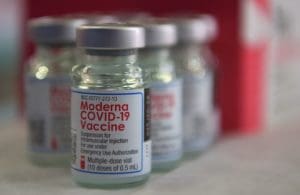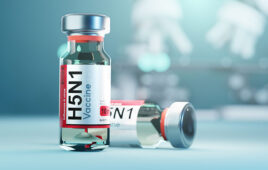
Vials containing the Moderna COVID-19 vaccine. Image from Wikipedia.
A segment of the population is wary of COVID-19 vaccines. One of the main reasons why is the rapid pace at which they were developed.
But the mRNA vaccines FDA was able to authorize in late 2020 were years in the making, stressed Kizzmekia Corbett of the NIH at CDC’s National Forum on COVID-19 Vaccine virtual event.
The traditional vaccine development process, which typically spans years, was “shortened, but no integrity was lost,” Corbett said.
Scientists at the NIH have studied coronaviruses for several years, said Corbett, who leads a research team there focused on coronavirus vaccines.
One central factor driving the rapid development of mRNA COVID-19 vaccines was the collaboration between laboratories, institutions and companies across the globe.
“And then secondly, there was extensive work on MERS and other coronaviruses that really set the stage for our fundamental scientific understanding,” Corbett added.

Kizzmekia Corbett. Image courtesy of Wikipedia.
Years before the current pandemic, researchers concluded that the spike protein in MERS-CoV was a key target for antivirals and vaccines.
“For the last several years, we’ve studied that [spike] protein in such detail that we were able to understand how to make a really good vaccine from it,” Corbett said.
The learnings were instrumental in understanding how to create mRNA vaccines against SARS-CoV-2.
In early January 2020, Chinese officials announced that the respiratory illness that emerged in Wuhan in late 2019 resulted from the novel coronavirus. That same year, on Jan. 10, researchers made the first sequence of the virus’s genome available.
Just over two months afterward, on March 16, Moderna (NSDQ:MRNA) announced that it had dosed its first patient with its mRNA-1273 COVID-19 vaccine.
The rapid timeframe was made possible because of the years of prior preclinical testing, Corbett stressed.
Researchers knew the “vaccine was safe and created a really good immune response in animals such as mice and monkeys prior to ever testing it in a human,” she said.
The high efficacy of mRNA vaccines — in the range of 90% to 95% — is the byproduct of solid preliminary research, which informed subsequent clinical trials. “It is important to note that while it is rapid, this process of vaccine development is systematic and without any sacrifice in any of the steps, whether it be on the clinical side, from which I led, or through the phases of the clinical trials that followed,” Corbett said.
Filed Under: clinical trials, Drug Discovery, Drug Discovery and Development, Infectious Disease



